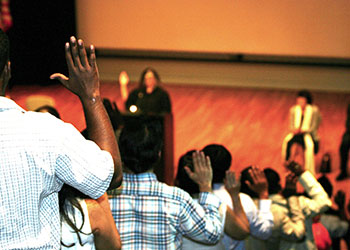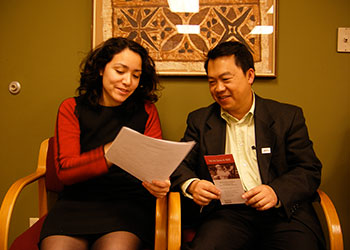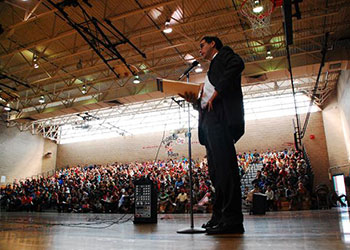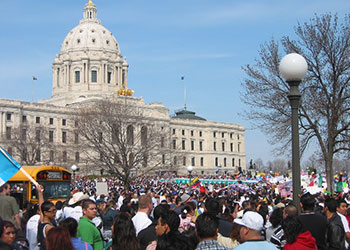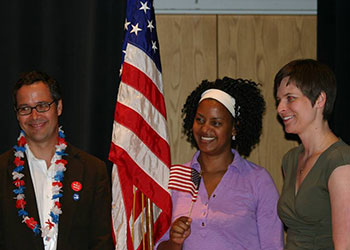News > Immigration In Minnesota
Getting to know new Minnesotans – Part Three: Who can get in line?
Posted on May 21 2017
You’ve heard it many times, maybe even said it – why don’t they just get in line? Minnesota has an estimated 90,000 – 100,000 undocumented immigrants, many of them living here for five, ten, twenty years, raising families, working, paying taxes – why don’t they just get in line? The answer is pretty simple: for most people, there is no line.
Immigrants make up 13.5 percent of the national population but only 8.3 percent of Minnesota’s population in 2015. The “Getting to know new Minnesotans” series explores some of Minnesota’s immigration picture. Click to read Part One: How many immigrants? and Part Two: Where do they come from?
Immigration to the United States is severely restricted. If you want a permanent resident visa, you need to have special qualifications. Since 1920, a quota system has restricted the numbers of immigrants by category and by country. That quota system has changed in various ways – mostly becoming more complicated – over the years, but most immigration today is still based on quotas and special statuses.
One exception to quotas: Spouses and unmarried minor children of U.S. citizens, and parents of adult U.S. citizens can generally immigrate “quickly.” With processing delays, “quickly” usually means a year or more.
Not all spouses, parents and children of U.S. citizens can get these visas. If a spouse or parent or child has previously entered the United States without authorization, they still might be barred from getting a visa, sometimes for three years, sometimes for 10 years, sometimes longer.
Except for these immediate relatives of U.S. citizens, an immigrant needs special qualifications to be allowed even to apply for a visa – to “get in line” for the limited number of visas available each year.
- Family preference –An adult child or a brother or sister of a U.S. citizen or as a spouse, a minor child, or an unmarried adult child of a legal permanent resident can apply. If you qualify for a family preference visa, you can get in line. The lines stretch out for years and sometimes for decades.
- Refugee or asylum – People can apply if they can prove they are in danger of persecution because of race, religion, political opinion, nationality, or membership in a social group. The vetting process for a refugee application takes years. And, again, the United States strictly limits the number of people who can enter as refugees.
- Employment – A highly skilled or exceptional individual (think Einstein or a major league baseball star) who is sponsored by an employer can apply for one of a very limited number of visas;
- Investment – Somebody with half a million dollars or more to invest in the United States can apply for a permanent resident visa. Someone like the investors meeting with Jared Kushner’s sister in Beijing, for example.
- The lottery – USCIS describes it: “The Diversity Immigrant Visa Program (DV Program) makes up to 50,000 immigrant visas available annually, drawn from random selection among all entries to individuals who are from countries with low rates of immigration to the United States.” That last phrase is important: countries with low rates of immigration to the United States means no one from these countries is eligible to even enter the lottery: Bangladesh, Brazil, Canada, China (mainland-born), Colombia, Dominican Republic, El Salvador, Haiti, India, Jamaica, Mexico, Nigeria, Pakistan, Peru, Philippines, South Korea, United Kingdom (except Northern Ireland) and its dependent territories, and Vietnam.
Twenty-four years ago, Juana left an abusive relationship, taking her twelve-year-old son and her ten- and eight-year-old daughters with her. Together they walked for six hours across the desert, leaving Mexico for the promise of a safer life in the United States.
The family was captured by the border patrol. Juana and her children ended up back in Tijuana—and in jail. Her son was jailed with the men, separated from his mother and sisters for long, fearful hours, until they were all released. Once again, they headed back to the border, this time making it across.
They came to Minnesota, a place Juana called “more beautiful than the movies.” Juana and her children lived here for 14 years. She worked hard and paid taxes, raised her children, and saw their children born as U.S. citizens. Then, ten years ago, Juana was arrested and deported again.
Juana never had a chance to stand in line. There was no line for her – not in 1993, not in 2007, not today.Our immigration system is broken. Comprehensive immigration reform is needed, but comprehensive immigration reform has been blocked for years.
